#Commercial Water Filtration San Marcos
Text
B A R A N G A Y K U W E N T U H A N
T H R O U G H T H E L O O K I N G G L A S S : An Exploration Into Our Own Communities
By: Cristina Paula E. Castro

In the time of expansion, it had become easy for us to overlook our very own locales when we discuss about society. Today, we tend to look at the Macro Perspective of things without considering the smaller components that make it up. As we analyze the society in a global perspective and national perspective, it is important for us to also look into the tiny communities that make up our kaleidoscopic world. This is precisely what the University of Santo Tomas’ National Service Training Program enables students to do.
In a task to interview barangay officials about the hazards, vulnerabilities, capacities, and risk reduction abilities of the community, I was able to interview Mr. Marco Dan C. Salvaña and Mr. Fernando D. Concan about the conditions of Barangay San Isidro.

Shown in the photographs are Mr. Marco Dan C. Salvaña and Mr. Fernando D. Concan.

The interview began with the simple identification of the existing hazards for the community. Mr. Salvaña had identified two of the top hazards that threaten the community; fire and flood.

Mr. Fernando D. Concan signs the letter of consent.

Below is a photograph during the interview. Unfortunately, Rm. Marco Dan C. Salvaña requested not to be shown in the photograph on the day of the interview itself as discretion because he was in his school uniform.

While Barangay San Isidro sits in a heavily urbanized city, there are still portions of the barangay with less developed housing. With fire being unpredictable, it poses a huge threat to every area, especially those of which are compounds with houses and establishments made of light materials. The barangay has specific areas such as the Silverio Compound and the creek side of Valley 02 which are populated by informal settlers. As the houses and buildings were not planned with as much care as the other infrastructures within the barangay, fire easily spreads throughout these parts of the community. Earlier this year, a large fire consumed a commercial hardware establishment which is largely constructed with flammable materials. As a result, the whole area that it covers was consumed by fire. In the previous years, small fires that spark within Silverio Compound, Barangay Village, and the border near Santo Niño have created a great damage to the community due to the fast growing of the fire and due to the unpreparedness of the community during that time. Today, the Disaster and Risk Management Division of the barangay considers fire as the number one hazard to the community.
Unlike other phenomena, typhoons and rainstorm are largely predictable. Because of this, flooding has become less threatening for the barangay and disasters due to natural phenomena has become less frequent throughout the years. Still, the improve canal systems are only partly effective in alleviating this problem in certain areas. Although the city is situated in flat land, certain areas have been constructed with uneven roadwork and are located in lower land areas. Such places include Lopez Village, Vitalez Compound, and Matatdo Homes. Apart from this, there are also small bodies of water within the barangay. During the wet season, these bodies of water overflow and cause light flooding to sever flooding in the areas surrounding it. Such creeks include the inner part of Valley 02, the creek in the main road of Greenheights Village, and the lower part of Matatdo Homes.
Apart from these two hazards, the barangay also considers the possibility of an earthquake as a major hazard. While the barangay is not situated on the Marikina Valley Fault System which runs through Metro Manila, the barangay maintains serious earthquake preparedness as the city itself is situated near the areas along the fault line. Large structures such as the express way, abandoned buildings which have not been retrofitted, unfinished buildings, and newly constructed buildings may collapse during a strong earthquake. Apart from damaging its surrounding structures, it may also be a direct cause of the loss of life of the people. Such is observed in the neighboring barangay, Barangay Tambo.
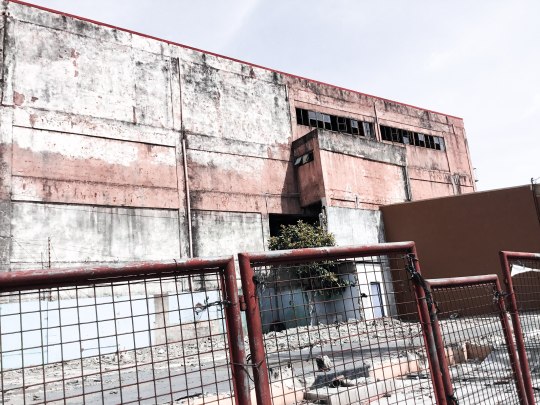
Here are some of the photographs of abandoned and unfinished infrastructures found within the barangay.

Mr. Concan has mentioned that these hazards and risks are reviewed quarterly by the division, headed by the barangay chairman, Capt. Noel J. Haplos. While the division team is responsible for most of the operations, the projects are often proposed and organized by the barangay chairman as he is the one who coordinates with the neighboring barangays about the affairs of the community.
Prior to the heightened involvement of the people in the community in disaster management, the barangay was focused on the response to disaster alone. However, as more youth organizations sprouted along the line, the barangay was able to coordinate with these associations to educate the capable members of the society on how to prevent, prepare, and respond to a disaster. In the unfortunate instances wherein disasters and calamities caused a devastating impact, the division is only able to respond to select areas at a time due to blocked roads and disrupted signals. After a brief recovery period, the disaster team tasks individuals to gauge the damage caused to the community, its probable root cause, and how to address the said problem. Since then, the barangay, in coordination with the city, was able to improve waterways, acquire appropriate weather instruments, develop evacuation plans for the different sub-areas of the barangay, and distribute necessary items during emergencies and during calamities.
The community walk enabled me to see first-hand the key places within the barangay. We were able to visit the most hazardous places or the areas which are most likely to acquire the most damage in times of disaster.

Shown above is the entrance to San Antonio Valley 02.

Pictured above is the entrance to Silverio Compound, and below is a snapshot of the area.

For fires, the areas that are most susceptible to this hazard are Valley 02, Silverio Compound, and Barangay Village. There are large portions of Valley 02 with infrastructures that are very closely built. There are also less-developed portions in the compound with homes that are built with substandard materials. Silverio Compound, which lies near the barangay hall, is a relatively large area occupied by informal settlers. Because of this, the landscape of the compound is poorly planned with narrow roads, overlapping houses, and poor street system. In addition, the houses that populate the area are pre-dominantly made of thin wood planks and metal gals. During instances of fire, the fire department of the barangay finds it difficult to respond as soon as possible due to the narrow labyrinthine streets which block fire trucks from entering the compound. It is also doubly challenging to extinguish fires as the houses are stacked against and atop other houses. Barangay Village also houses an area of poorly-constructed homes that are compressed in a small land area. Because of this, it becomes difficult to trace the exact place from where fires specifically spark. The damage is also more fatal as the fire easily spreads in the small area which houses a large number of people.
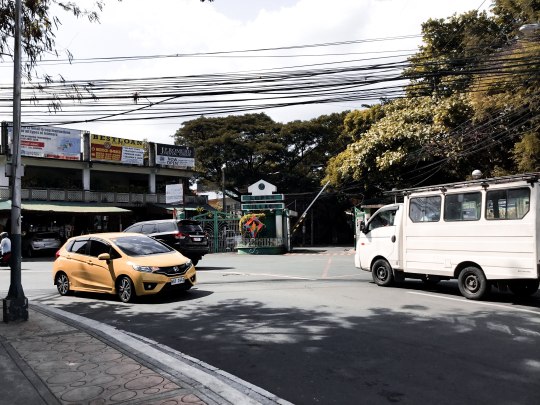
Shown above is the entrance to Lopez Village. Entering the village is not possible during the time of the community walk as non-residents are not allowed to enter the premises without a letter from a homeowner.
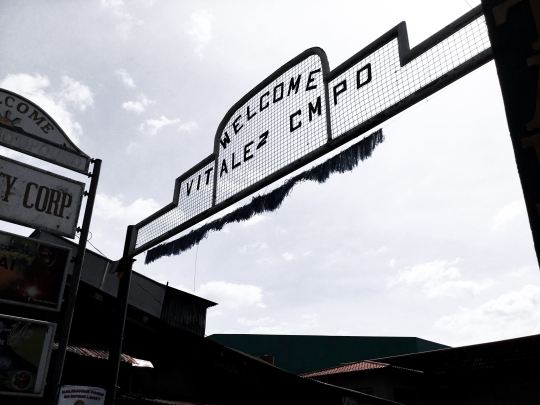
Pictured above and below is the entrance to Vitalez Compound.

Pictured below is the downward slope of a street in Vitalez Compund.

The uneven ground level in Vitalez Compound is one of the reasons why it is susceptible to flooding.
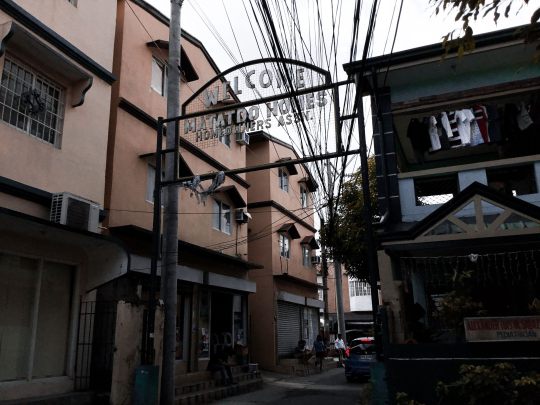
Pictured above is the entrance to Matatdo Homes. Below is a photograph of the lower portion of the compound near its southern border.
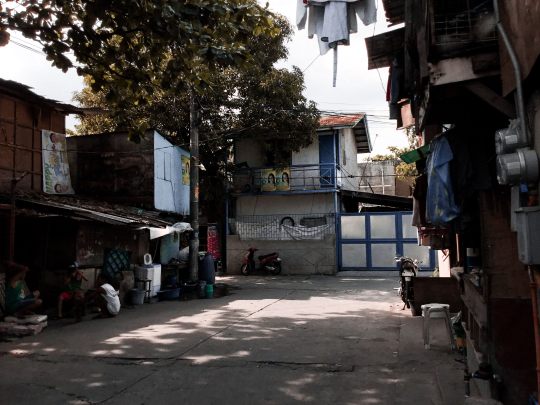
Pictured below is the gate of Greenheights Village.

The two photographs below are the two parts of the creek located inside the premises of the village.
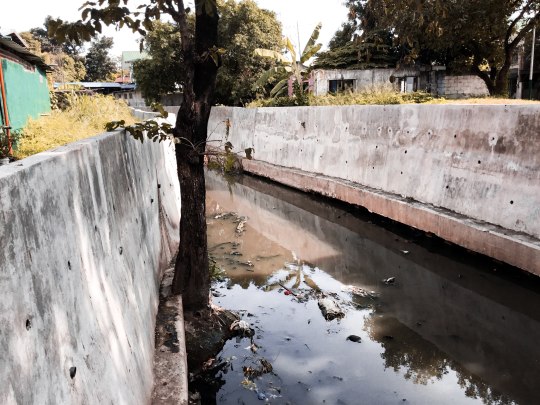
As one observes, the sides of the creek have now been cemented. However, the marshy part of the creek is yet to be cleared.
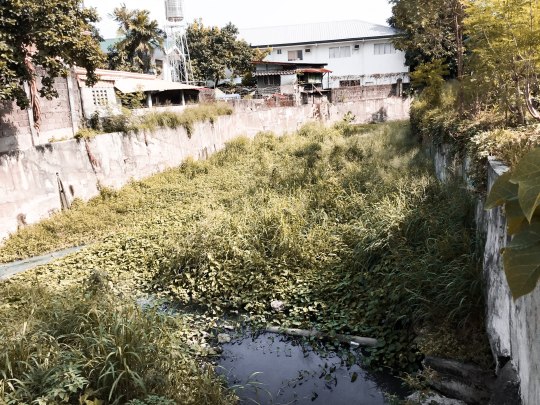
The most affected areas for flooding are Lopez Village, Vitalez Compund, Matatdo Homes, and a small portion of Greenheights Village where a creek is located. Lopez Village, Vitalez Compound, United Parañaque Subdivision 05 (shown below), and Matatdo Homes are similarly characterized by lower land area, poor drainage systems, and uneven roadwork.
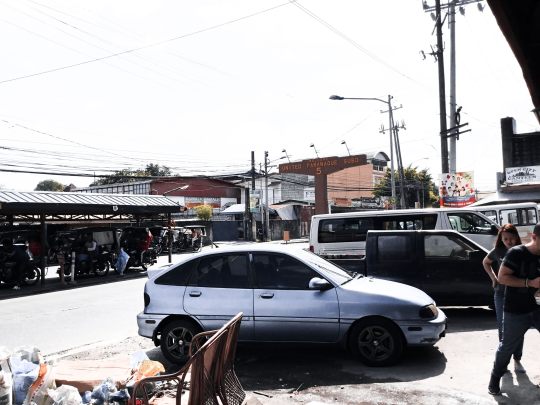
As a result, the rainfall from other areas of the barangay are caught in the said areas. The clogged drainages in the said places also contribute to the pooling and non-filtration of rainwater. As for Greenheights Village, although the subdivision is considered as one of the safest place within the barangay, the creek within its territory easily overflows during typhoons. What is more unfortunate is how the said creek is located at the middle of one of the schools, Escuela De San Lorenzo Ruiz, whose two buildings are connected by a bridge that passes over the creek. Apart from its nature as a body of water, the creek is also heavily polluted and is dirtied by garbage. This contributes to the impeded flow of water.

Of course, the barangay also has a list of the safest places within its territory. While the villages such as Greenheights Village and Krause Village are considered safe, the barangay only advices one place as a truly secured place in times of disaster. This is the Manila Memorial Park. While the place is a cemetery, it is considered to have one of the best area designs in the city. In fact, it is considered as the main evacuation point in case a large disaster hits the city. It covers a large area of flat land, has a very small number of structures that may collapse, and is on a relatively elevated part of the city. While there is also a body of water within its premises, the said body of water rarely overflows as the land area it covers is larger than that of the smaller creeks within the barangay.

The Manila Memorial Park which is pictured above and below serves as the emergency evacuation site of the whole barangay and its neighboring barangays.
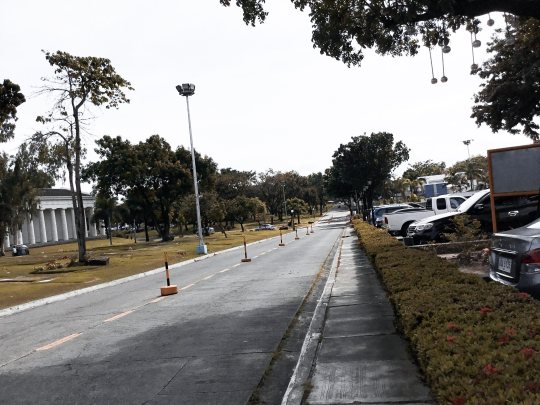
Of course, the barangay has ways to mitigate and manage the situations and conditions at hand. According to Mr. Salvaña and Mr. Concan, the barangay began by cleaning the drainage systems and addressing the overflowing of the creeks. As observed, the creek in Greenheights Village has since been cemented and today, the water rarely overflows as some efforts were made to clean the body of water. The disaster management division also holds seminars, trainings, and tournaments in the different villages and subdivisions of the barangay every four months based on the safety map that they have in their office. The participants are often youth members and these events are done in coordination with the different home-owners associations. I was informed by the interviewees that during these trainings, equipment such as manuals, first aid kits, and fire extinguishers to different households. Another one of the progressive and helpful practices in the barangay is how the local government is willing to give enough budget for the procurement of equipment needed for disaster management and for emergency responses during disasters and calamities. Such can be seen in the office of the disaster management division. In addition, Mr. Salavaña and Mr. Concan has also informed me that most of the members of the community have began to appreciate the need for preparedness. As a result, they no longer need to approach the different communities one by one as the respective associations of the said communities are now the ones to volunteer in sponsoring and pin participating in the events and projects that the disaster management division plans. Because of this progressive behavior the team behind the barangays disaster management is able to continuously improve. Now, they are even approached by schools such as the Philippine National University and the Far Eastern University to teach disaster preparedness and to educate on hazard and risk management in the said institutions.
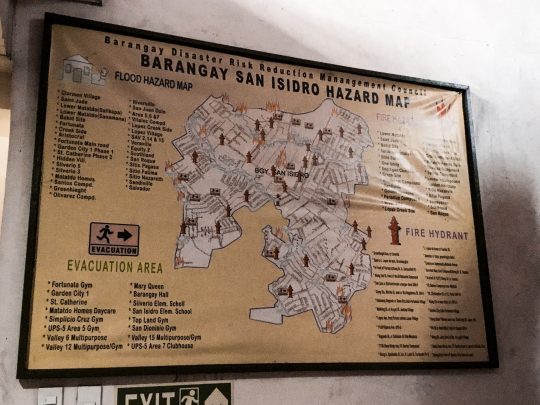
Pictures above is the Barangay Hazard Map and below is the manual that is distributed to the residents.

As shown below, the Barangay San Isidro is a recipient of recognition for its efficiency in disaster management and preparedness.

Pictured below are some of he available equipment for response emergencies.

Fortunately for the barangay, the interviewees have informed me that there are very little concerns when it comes to disaster management in terms of the participation of the people. However, the trainings are only often attended by youth members. The main concern as of now is keeping the residents of the areas most susceptible to damage safe. Mr. Salvaña admitted that the team is unable to respond to all of the places at the same time during large calamities. He has also raised his concern on improving the conditions of the communities of informal settlers as it is not feasible or possible for the local government to provide better housing or better infrastructures for all of the residents of the said areas. This, of course, is understandable. The government needs to wisely consume its budget and with the thousands of homes within the hazardous areas, it is simply not probable or ideal for new homes to be constructed. Such a concern is raised as the said residents do not have the financial capacity to acquire better homes. Personal safety equipment is also not as accessible to certain parts of the community as they are to some of its other members due to economic status. In times of disaster, the people who live in the most hazardous areas are at a steep disadvantage as they receive the largest damage and have the least capacity to rehabilitate their homes and livelihood which may be destroyed during disasters. In the case of the barangay, the composting farm is located beside the creek in Greenheight Village, placing it in the direction greatly affected by the flooding that is caused by the creek.

The Faith Garden is a composting garden where common vegetable products are grown.

In response to this, the local government can focus on the prevention of the devastating effects of calamities and disasters from happening. As much as possible, the government must improve the public spaces where the hazardous places are. This includes cleaning and improving the drainage systems and fixing the already damaged roads and streets of these areas to ensure that emergency response teams can easily access these places when needed.
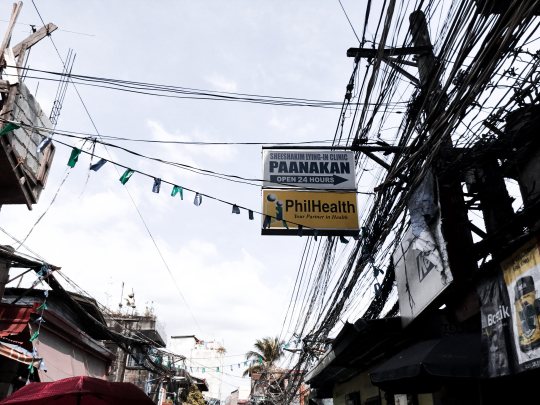
Pictured above and below are the streets of Silverio Compound.

Although some may negatively interpret it, the resilience of the people must also be strengthened. This includes effective emergency plans and consistent drills in preparation for disasters. An evacuation map for each community must be provided and evacuation practices must be continuously held in these areas. As an example, Kalayaan Village in Rizal holds these drills every few months to train the residents for an orderly and smooth evacuation in case a large calamity of an unpreventable disaster strikes. With the sprawling coverage of areas like Silverio Compound, it is important for the people to be trained for emergency situations and to be informed of the best routes to exit the area affected by the disaster. It is not realistic for the government to guard every area of the barangay during disasters. As a result, we as residents must also be informed and prepared.
There are instances when disasters cannot be prevented. However, we can improve the response to such disasters. The local government must make sure that emergency lines are available at all times and emergency response teams are present and well-equipped especially when the barangay already expects a certain disaster to hit. The local government can also heighten efforts in encouraging the community to volunteer as trained response team members. In addition, lessons on first aid may also be taught to the members of the community. This will enable every individual to be knowledgeable about emergency health care and able to provide temporary care to casualties in times of disaster. It is commendable that first aid kits are already being distributed in the households within the hazardous areas. However, this will not be truly beneficial if the people do not know how to properly administer first aid. As an addition, it would also be beneficial if weather-predicting instruments are given to the communities that live in more hazardous areas. The interviewees have informed me that such instruments are situated in Greenheights Village. While it would indeed be better for all of the areas to have their own gauges, it might prove to be more effective to provide these instruments to those who need it more. This way, the said areas would be able to know first-hand the nature of the typhoon that may hit in order for them to prepare immediately.
Similarly, these challenges are also present in the country as a whole. There are people and communities which are more vulnerable than others. First, the aging community and individuals with disabilities who have no immediate guardian may find it more difficult to respond and adjust during disasters. Not every Filipino live in places that are safe from calamities and disasters. Apart from this, not all of the citizens of the country have the means and capacity to pick themselves up after disasters that have heavily destroyed their homes and sources of livelihood. One of the biggest issues in terms if disaster management is the limited budget to acquire instruments in accurately predicting the strength of typhoons, to purchase enough and quality equipment for rescue operations during disasters, and to reach far-flung areas that have little knowledge on disaster manage and little means to rehabilitate their local community on their own. There are also a lot of illegal residential areas that are located in hazardous places. As a result, the said areas become a catch-basin for flood, a hot-spot for fire incidences, and highly dangerous places during earthquakes. In addition, a significant number of people even in the cities do not participate in disaster trainings with seriousness. During fire drills and earthquake drills, a number of people make a joke out of the situation and consider the activities as a waste of time. In first aid activities held in one of our classes in the National Service Training Program, some students who are laughing about the activity can be observed. This creates an unhealthy environment when it comes to teaching disaster management. In both the local and national sphere, the government cannot be the only entity responsible for disaster management. We, too, must be willing to support the projects of the government to address the problems concerning disasters by participating in national drills and volunteering to learn basic skills to raise the capacity of our community to reduce the damage that comes with calamities and disasters.
The interview, or as our facilitator pertains to it, the kuwentuhan, was truly a fruitful conversation. My appreciation for the whole team behind disaster management both in our barangay and in other barangays have grown more. Seeing how passionate the members were in their task made me realize how face our concern for the society around us can go. It has also made me appreciate my fellow residents as well who take it upon themselves to volunteer as members of the emergency response units despite having their own personal duties in work or in school. Hearing how the overall management of disaster in the barangay improved as members of the community began being more involved had made me realize how important it truly is for each individual to play his or her duty. Involvement in the community is a necessary aspect in the progress of the society. In a way, we must all use our resources and capabilities to look out for each other.

The photograph above is taken during the community walk while the picture below is taken before the community walk. With me are the members of the barangay’s fire and disaster management team.
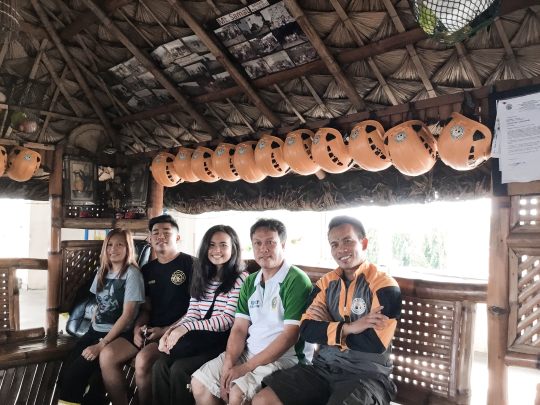
Seeing the different areas in our barangay has made me more aware of the disparity that exists even within one location. The hazardous places and safer places pose a stark difference between each other, much of which was due to economic differences. This disheartened me as such conditions should not be the reason why the lives of a group of people is placed in a graver danger than those of others. Because of this, I am even more dedicated to supporting advocacies that aim to address the inequalities in the society. As we can see, such issues are not merely concerned with education or profession; they also permeate to the capacity and vulnerability of an individual.
As one may have realized by the end of the activity, there are countless challenges to overcome when it comes to the disaster and risk management of the country. As a tropical country and as a nation that is located in the Pacific Ring of Fire, we are a hot-spot for natural calamities on top of man-made disasters. Striving to establish responsible disaster risk management among individuals should not be seen as a way of romanticizing the resilience or the ability of the Filipinos to adapt. Instead, it must be seen as a priority to prevent the damage to life and to property during catastrophes. As we are now aware of, safety from tragedies, whether natural or not, is not guaranteed for all of us. Thus, those who have the capacity and capability to help those in more vulnerable situations must be willing to assist in times of need. With an average of twenty typhoons entering the Philippine Area of Responsibility as estimated by the Philippine Atmospheric, Geophysical and Astronomical Services Administration, twenty-three active volcanoes, and active earthquake activity on top of armed conflict in certain areas and the unpredictability of fires accidents, it is important for all of us to be aware and prepared. To begin this, we must first be willing learners when it comes to the topic at hand.
Being a member of the youth should not limit us from being active members of the society. In fact, I was fortunate enough to take a photograph with the fellow members of the youth; volunteers who were taught Basic Life Support at the same time I interviewed the barangay officials. The photograph below shows the youth volunteers and beside me, the organizer of the event and barangay chairman, Mr. Noel J. Japlos.
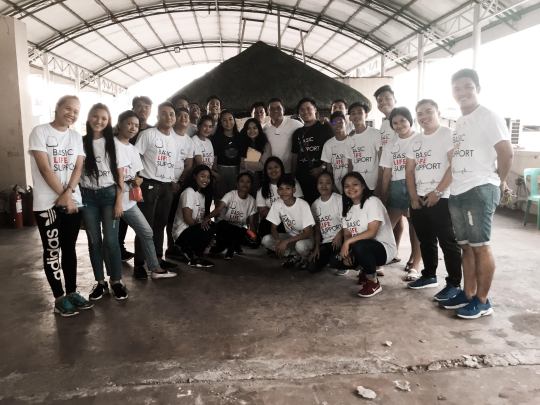
The active participation of the members of the community in disaster management is also one of the best practices within the barangay.
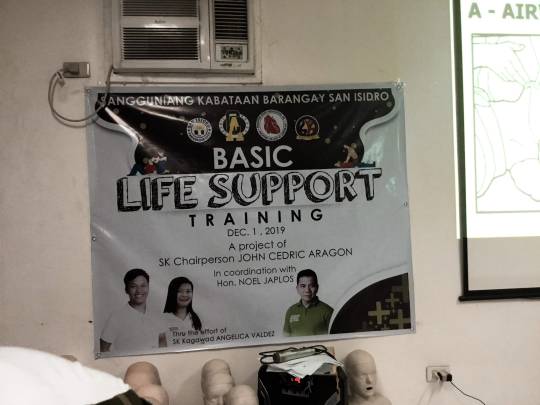
As young individuals, we have great capability to use our time and energy in volunteering to become responders during emergencies. The interviewees that I had the pleasure of having a conversation with has invited me to become a part of the youth responders in our barangay. In addition, even our own university offers a chance for us to participate in disaster management by holding first aid seminars and by offering opportunities to be part of the Philippine Red Cross. Of course, it is not possible for us to magically give a solution to areas with substandard infrastructures and to re-build stronger homes for our fellow Filipinos. What we can do is participating in the projects of our local communities where people are needed to teach skills related to disaster management. As individuals who are quite informed of effective disaster plans, we can use our learning to pitch project ideas and improved area designs for evacuation or for improvement. Even these small acts increase the capacity of our own community by boosting the number of individuals who are capable of addressing the problems brought by catastrophes.
As a student myself, I can accept the offer of the community to participate and train for the response team. Apart from being a responder, I would also be given the chance to pitch in my ideas on disaster management which I have learned during the course of the National Service Training Program Class that I have taken in the university. Of course, my knowledge is definitely not on par with my superiors. However, this will also be a good opportunity for me to learn new ways to become a more productive member of society.
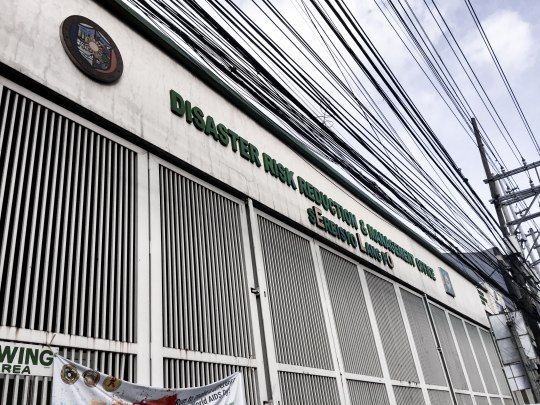
Pictured above and below are the facades of the two buildings that serves as the home for the city’s Disaster Risk Reduction and Management Office, located beside Barangay San Isidro’s hall.

I was informed by Mr. Salvaña that while the village I reside in, Greenheights Village, actively supports and sponsors the disaster management division of our barangay, there is yet to be a youth organization within the village with whom they can coordinate with for more physically demanding projects. As a resident of the village, I may approach the local association about the formation of such a group. This way, we can help in addressing the barangay’s need for manpower. As younger members of the society, the more rigorous activities that come with disaster management will be more easily performed by our age group than by the more elderly members of the community. The capacity of communities in not only measured by emergency actions. Political and social involvement must also be considered. In time, the learning that our group and organization would have acquired may be used to pitch ideas to the local government on better means to improve disaster management. This may range from simple seminars and drills to the annual provision of emergency equipment to the communities within the barangay. Even increasing the number of fire hydrants around the barangay can prove to be an effective measure towards preparedness. As the City of Parañaque heavily involves its youth members in projects, we have the opportunity to play concrete and proactive roles in increasing the capacity of our community by proposing realistic and sustainable policies on disaster management. Such policies include those that are focused on equipping individuals of knowledge about disaster and risk management and empowering individuals on disaster preparedness and response.
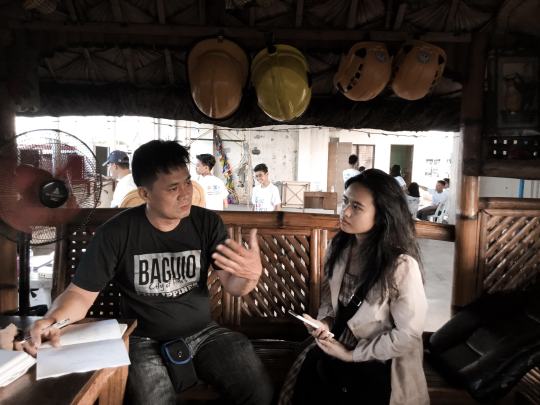
Mr. Fernando D. Concan poses for a photograph during after the interview.

The session of the interview had taught me innumerable lessons not only about disaster management, but on the entire concept of community as a whole. With a spark of hope and resolution, I left the confines of the barangay hall being more positive about my personal ability to become of greater help to my community.
2 notes
·
View notes
Text
The Top 5 Water Filtration Systems for Your Home
5 Stage RO Installed
Despite common belief, not all water is “good” water. Unfiltered water can contain all types of debris, chemicals, minerals, impurities, and other physical properties that can change its taste and smell. Unfortunately, the same contaminants can also be harmful to one’s health when consumed regularly. Many bacteria and microscopic organisms in tap water can lead to mild-to-severe illnesses.
Not only does a water filter purify water of contaminants and makes the water safe to drink, but it also improves the taste and overall quality. For example, reverse osmosis systems are considered safe for patients who are undergoing cancer treatment, as the filtration ensures that the water is healthy and contaminant-free.
Noteworthy Benefits and Uses for the Top Five Water Filtration Systems
Here is a list of the top five water filtration systems available in the greater Texas area. Each one has distinct qualities, advantages, and benefits, which include:
10″ Whole House Sediment Filter Housing – 20 Micron Filter System:
Resistant to chemicals and suspended solids.
Captures and removes waterborne contaminants such as rust, sediment, silt, and sand without reducing the water flow.
Constructed with a coreless design, binder, and filter that is adhesive-free.
Utilizes 4 separate layers of depth filtration for quality assurance.
Tested and Certified under NSF International under ANSI/NSF 42.
Inexpensive prefiltration solution for whole house water filtration.
Prevents corrosion from galvanized plumbing from entering the water supply.
Filter replacement is conveniently bi-yearly for maximum performance.
Aside from being a popular option for homeowners, sediment filters are also commonly used in restaurants and coffee shops to ensure excellent food and beverage quality.
Catalytic Carbon Filtration System with Back Washing Valve:
Centaur catalytic carbon media is specifically prepared for the removal of chloramines.
Many health hazards are linked to chloramines, such as skin problems, kidney complications, and digestive issues to name a few.
Chlorine, disinfection by-products, VOC, and pharmaceuticals from municipal water supplies are all removed by the filtration system.
This is an effective solution to remove Hydrogen Sulfide from water that is sourced from a well. Hydrogen Sulfide consumption is linked to symptoms such as headaches, fatigue, and nausea.
This system makes a great whole house filter for city water use as well, especially when chloramines are present.
Provides 4 gal/min flow rate per cubic ft. of carbon media for maximum removal of chloramines.
Many people who have switched to a catalytic carbon filtration system happily report seeing improvements in skin complexion and softer-feeling hair after regular use and water consumption.
Iron Breaker Filter System:
Controls and eliminates H2S (rotten egg odor) and iron, which are most commonly found in well-sourced water.
Natural, chemical-free alternative to treating problem water. It utilizes nature’s own oxidation process without the need for aerators, compressors, or external ventures.
Eliminates yellow/brown staining on plumbing fixtures from iron and increases the longevity of appliances, plumbing, and clothes.
No need to handle harsh chemicals or regularly maintenance complicated equipment, which makes enjoying clean water easy every day.
UV Light Disinfection Filtration System:
A reliable and economical way to safeguard drinking water for both residential and commercial premises.
Being chemical-free, it eliminates the need to handle hazardous chemicals entirely.
An environmentally-friendly option that requires low energy consumption.
Ideal for well water applications where microbes and bacteria are present.
Removes E.coli, Cryptosporidium, and Giardia to deliver safe worry-free drinking water.
Easy maintenance and affordable equipment costs and installation.
Sand Separator
Removes sand and dirt inside residential or commercial water supply that restricts flow, clogs fixtures, and damages appliances.
Best application for water containing heavy sand, silt, or dirt content.
Eliminate all backwashing from the water.
No cartridges to change or screens to clean.
Contains a simple purge valve to flush all sand and dirt. An optional auto-purge valve can also be installed.
NSF Certified.
Deciding on a water filtration system that best fits a property’s needs can be a challenge, as well as overwhelming. When considering all of the advantageous and uses each system has to offer, it is essential to ask yourself which system best fits your requirements and expectations.
If you find that you are still struggling to make a decision, seeking the help of a trusted water filtration company can help guide you in the selection process. A water treatment professional will assess your property and expectations in order to make the best recommendation possible.
Still Not Convinced? Consider the ”Bigger Picture” Advantages Water Filter Systems Provide
Commercial Water Filtration And Reverse Osmosis System
Proper hydration helps the body get rid of toxins, maintain an ideal weight, and produce essential bodily fluids. Adequate water intake also contributes to increased energy levels, fewer headaches, better health, and hydrated skin.
However, insufficient water consumption can increase your chances of developing chronic fatigue, higher levels of toxins in the body, sugar cravings, premature wrinkles, and many other undesirable symptoms.
With the human body being made up of 60% water, it is no stretch to say that water is life. The quality of water one drinks is as essential as regularly consuming enough water to stay hydrated. Here are some of the best benefits water filters can provide:
Water softeners and filters beat out water bottles in almost every way. Surprisingly, many water bottle companies have a smaller set of regulations than most tap water.
A water filtration system is environmentally-friendly and reduces the use of plastic bottles. It is no surprise how polluting plastic bottles are to the environment. On average, 80% of plastic bottles go unrecycled and 24 million liters of oil are used to produce plastic bottles. Switching to a water filter helps reduce these statistics and lessens one’s carbon footprint on the environment.
On average, those who drink from a water filter enjoy the taste more. It is crisper, odorless, and more refreshing. It also provides better water quality for all of your cooking needs.
You will save money in the long run. According to the EPA, the average cost of a gallon of bottled water is about $1.20. Tap water, on the other hand, is about $2/1,000 gal. When compared, bottled water is over 600 times the cost of tap water. Over a lifetime, it adds up!
You are more likely to drink water. The upfront investment of a water filter is a commitment to a healthier lifestyle. Moreover, with the improved taste in water, you’ll find fewer reasons to reach for other beverages.
Whether your goal is to improve the quality of water for your loved ones or your customers and employees, a water filtration system can help reach those goals. It is the most cost-effective and efficient way to improve long-term water consumption.
To learn more about water filters and how installing a system can benefit you, reach out to Basin Water Solutions today. Their company has over 36 years of experience in the water treatment industry and is a top-water solution provider in the local communities. They can assist you with everything involving water filters and provide you with details, such as the installation process, affordable costs, and which system best fits your particular residential or commercial property. They proudly serve San Marcos, TX, and the surrounding 100-mile radius.
1 note
·
View note
Text
Licensed San Diego Plumbers On Duty. Don’t put up with a damaged or inefficient toilet repair in san Marcos ! Our team at Moore Plumbing and Drains is happy to provide affordable toilet repairs and replacements.
#Plumbing Solutions San Marcos#Commercial Plumbing San Marcos#Commercial Water Filtration San Marcos#Residential Water Filtration San Marcos#Commercial Water Softners San Marcos#Residential Water Softners San Marcos#Boilers Installation San Marcos#Tankless Water Heaters Repairs San Marcos#Electric Water Heaters San Marcos#Gas Water Heaters Installations San Marcos#Gas Water Heaters Repairs San Marcos#Sewer Camera Inspections San Marcos#Hydro Jetting San Marcos#Clogged Drains San Marcos#Roots in Sewer line San Marcos#Sewer Installation San Marcos#Sewer Replacement San Marcos#Sewer Line Repairment San Marcos#Commercial Drain Cleaning San Marcos#Residential Drain Cleaning San Marcos#Drain Cleaning San Marcos#Slab Leak Detection San Marcos#Gas Leak Detection San Marcos#Water Leak Detection San Marcos#Leak Detection Plumbers San Marcos#Gas Line Repair San Marcos#Repiping Plumbers San Marcos
2 notes
·
View notes
Text
5 Reasons You Need A Water Softener
Why do you need the best water softener for your home? First, let’s talk about the effects of hard water and how to determine if you have a hard water issue before determining if you need a water softener.
What is Hard Water?
The simple definition of water hardness is the amount of dissolved calcium and magnesium in the water. Hard water is high in dissolved minerals, largely calcium and magnesium. It can occur with both well water and city water.
In general, hard water is safe to drink and use for everyday tasks like washing clothes. But there are a lot of negative effects you might want to know when considering if you need to get a water softener.
Negative effects of hard water:
Your skin becomes itchy and dry
There’s a strange smell or taste of your water
Your dishes never seem to be super clean after washing them, leaving water spots or residue
The lifespan of your washer, dishwasher and other appliances that use water are dying out earlier than expected
The color of your clothes have faded or look dull
There’s excessive lime and scale buildup along the walls of sinks and showers
You have low water pressure
Learn more about the Five Hard Truths About Hard Water That Impact You and Your Home.
What is a Water Softener?
A water softener filters out and lessens the hardness of water. But not all water softeners are created equal. The best water softener systems, like at Basin Water Solutions, are ideal for all types of properties and provides the following benefits:
A complete line of professional water softener systems that are sized specifically for each household and water demand.
Removes minerals (calcium, magnesium) in hard water that causes scale deposits on plumbing fixtures, shower doors, dishes, etc.
Increases the life and efficiency of appliances that use water (washing machines, dishwashers, water heaters, etc.
Programmable computer metered 1″ control valve that delivers up to 27 gallons per minute flow rates.
Efficient control valve reduces water discharge and salt consumption during regeneration.
High-quality 10% cross-link resin to extend the lifespan of the resin bed.
Systems are backed by a 10-year warranty.
Top 5 Reasons You Need A Water Softener
1) Allows for softer skin and cleaner hair.
If you or a loved one has preexisting skin conditions, such as eczema, hard water can worsen symptoms. High levels of mineral deposits in water are also known to suck out moisture. A water softener can alleviate these symptoms and improve the quality of life.
2) Your water tastes better and there is no scent.
If your water has a “funky” flavor or scent, a water softener can help remove that to give you a pleasant drinking and washing water experience. It’s important to stay hydrated and clean, refreshing water is the way to go.
3) You spend less time cleaning your home.
The minerals in hard water tend to have an adverse reaction to soaps, making it difficult for stains and residue to go away. On average, water softeners reduce up to 50% of soap usage. Not only does this help save money in the long run, but it also improves the cleanliness of your dishes and makes washing them a little bit less of a daunting task.
4) Your clothes look brighter and bolder, and last longer.
The minerals in hard water do not mix well with detergent. Unfortunately, this occurrence usually causes clothes to become old-looking, dull, and worn much before their time. A water softener will improve the vibrancy of color in clothing, prolong its life, and ensure your favorite t-shirt stays feeling soft and comfy rather than itchy and scratchy.
5) Your appliances last longer.
According to The Water Quality Association, hard water damage wreaks havoc on most major home appliances. On average, a washing machine lasts 7.7 years instead of the expected 11 years when using hard water. In contrast, soft water helps exceed the expected lifespan on appliances and gets rid of stains at lower temperatures.
Read more about how to choose the best water softener system in your area.
Choosing The Best Water Softener
When you have a good water softening system, the minerals in your water will properly balance out. At Basin Water Solutions, our professionals are experts in the sales and service of water softeners, and specialize in:
Water softening services
Chloramine removal
Reverse osmosis system service
Water treatment systems
Water softeners
Water treatments
Water filters
Reverse osmosis system service
Commercial water softener
Water softener service
Water softener resin
Soft water treatment
Reverse-osmosis systems
Well-water treatment
For the best water softener solutions and whole house filtration services in Odessa, Denton, San Marcos, and surrounding areas, get in touch with Basin Water Solutions today. You will discover a surprising difference in the quality and taste of your water.
0 notes
Text
Finding the Best Reverse Osmosis Drinking Water System
What is Reverse Osmosis and Why is it Relevant?
5 Stage Ro System With Storage Tank
If your goal is to step-up your home’s water filtration system, reverse osmosis is the way to go. Whether the objective is to improve taste, quality, or reduce contaminants, a reverse osmosis water system is the best choice.
If you’ve ever had a glass of water that came from a reverse osmosis system, you know just how refreshing and crisp it tastes. This distinctive quality that separates it from other water filtration methods is due to the process the water undergoes. So what exactly is reverse osmosis and how does it work?
Let’s begin by talking about the process seawater undergoes to remove salt, desalination. To make water safe and drinkable, separating the salt is necessary. This process is called reverse osmosis.
Reverse osmosis is molecules passing through a semipermeable membrane that allows filtration. For example, in the case of saltwater, it passes through the membrane to a less concentrated solution. This action leaves freshwater on one side and salt on the other side. The same method works on other contaminants found in water, such as impurities, physical substances, minerals, and much more.
Reverse Osmosis Systems Vs. Other Water Filters
Reverse osmosis systems surpass other methods of filtration due to their unique process. Therefore, it is safe to say that when one is looking for taste, quality, and a seeable difference, a reverse osmosis system is the best choice when compared to other water filtration systems.
In many cases, the kitchen is the point of use of a reverse osmosis system. The reason for this is because many homeowners want to treat their cooking and drinking water. Not only does the water that receives reverse osmosis taste better to drink in comparison to other water filters, but many people report that it improves the taste of cooked meals as well.
In contrast, to reverse osmosis systems, other water filters tend to focus on treating the water of the entire building. The purpose of many water filtration systems tends to be for cleaning, laundry, bathing, and similar uses. However, the higher flow rate means a reduction in the quality of the water. The water is generally filtered but lacks the detail-orientated filtration level that reverse osmosis systems offer.
Potential Dangers of Unfiltered Water
The water we consume and the water that we use for daily tasks have different requirements. Ideally, one’s drinking water should be carefully filtered and free of all harmful contaminants because it enters the body.
According to the EPA, the Safe Drinking Water Act, a federal law set to protect public drinking water throughout the entire United States, regulates less than 100 contaminants. However, thousands of contaminants exist. Studies have also shown that drinking water that is contaminated, such as tap water, can lead to unwanted side effects, especially over a long period. Some of the potential hazards that correlate with contaminated water include:
Increase in one’s internal toxic load. Water is supposed to help the body flush out toxins. Unfortunately, when water is contaminated, it has a counter effect and may do the opposite of its intended purpose.
Possible contribution to poor skin conditions. Skin burns and rashes may worsen when exposed to contaminated water.
Exposure to harmful elements. Some harmful components found in drinking water include barium, traces of lead, chlorine, fluoride, mercury, PCBs, and more.
High probability of contaminants in water. In a research study that analyzed over 36,000 samples of tap water across the nation, it is estimated that as many as 6 million people are exposed to unsafe, toxic levels of drinking water.
Some of the chemicals found in unfiltered water are linked to health problems. The health problems associated with the contaminants include everything from compromised immune systems and digestive issues. For example, fluoride, which is commonly found in tap water, can negatively impact one’s thyroid gland. The thyroid plays a vital role in one’s overall health and healthy metabolic function.
There is no way to say for sure whether contaminants found in water will be detrimental to one’s health. However, the only way to ensure one’s water is healthy and free of harmful toxins is by proper filtration. A reverse osmosis system safeguards water consumption so that you and your loved ones can have peace of mind.
Get Healthier Water With the Best Reverse Osmosis System
At Basin Water Solutions, our 5 stages and 50 gallons per day reverse osmosis drinking water system provides the following benefits:
Most convenient and economical method of reducing unwanted contaminants found in drinking water.
It provides clean, clear, refreshing drinking water.
3/8″ Hydrofit Quick Connect fittings for full water volume flow.
High-quality sediment and double carbon prefilters.
TCF membrane element.
A coconut shell carbon polishing post-filter is included.
Optional 6th stage alkaline filter can be installed if desired.
Assembled with NSF components.
Includes high quality 3 Gallon RO storage tank.
Upgraded lead-free long reach faucet with multiple options for finishes to match current kitchen fixtures.
Backed by a 10-year warranty.
RO Drinking Water System with Booster Pump (2)
To learn more about reverse osmosis, water softeners, filters, and ways to improve the quality of your water sources in San Marcos and the surrounding 100-mile radius, get in touch with Basin Water Solutions today. They have over 40 years of industry experience when it comes to water filtration systems and helped many residents in the local community vastly improve the taste and quality of their water.
Basin Water Solutions specializes in the water improvement needs of both residential and commercial properties and can assist you in finding the best water solution based on your specific needs. Whether your goal is to have contaminant-free water drinking water for your home or business, they will provide you with options that best suit your requirements, expectations, and budget.
To find out more information about their services and to schedule a consultation, click here to get in touch with them. One of their friendly representatives will respond promptly and be more than happy to answer any questions you may have.
0 notes
Text
Finding the Best Water Softener System
Commercial Water Softener System
In a market saturated with water filters and softeners, it’s hard for homeowners to figure out which is the best water softener system for their homes. About 8.5 in 10 homes in the United States experience some degree of hard water and Texas is no exception to this statistic, with San Antonio being one of the nation’s top hard water metro areas.
Most water softeners on the market make promises of healthy, clean water that will improve the quality of one’s life on a day-to-day basis. However, many of the water softeners that make these claims only do the bare minimum.
Luckily, we’ve cut out the work and found the best water softener system. This water softener is ideal for all properties and provides the following benefits:
Removes minerals (calcium, magnesium) in hard water that causes scale deposits on plumbing fixtures, shower doors, dishes, and so on.
Increases the life and efficiency of appliances like washing machines, dishwashers, and water heaters.
Programmable computer metered 1″ control valve that delivers up to 27 gallons per minute flow rates.
Efficient control valve reduces water discharge and salt consumption during regeneration.
High-quality 10% cross-link resin to extend the lifespan of the resin bed.
A complete line of professional water softener systems that are sized specifically for each household and water demand.
Each system is backed by a 10-year warranty.
Five Hard Truths About Hard Water That Impact You and Your Home
The term ‘hard water’ refers to water containing impurities. Water, or H2O, contains two hydrogen atoms and an oxygen atom that create a water molecule. Unfortunately, that is not all our bodies consume when we drink water, as many other things get into our daily water sources. Not all of these impurities are dangerous, but several of the contaminants can be hazardous to one’s health.
According to a U.S. Geological Survey, about 85% of all homes in the United States contain hard water. This occurrence happens when rocks, soils, corroded plumbing, and other similar elements come in contact with water.
Here are a few telltale signs that hard water may be causing some problems inside your home and its time for a water softener system:
Skin is dry and itchy without making any major dietary or routine changes.
If you have recently moved into a new place and started experiencing skin irritation, it may be because of hard water. Taking a shower with hard water often leaves traces of soap on the body, which causes the skin to become irritant.
High levels of mineral deposits in water are also known to suck out moisture.
If you or a loved one has preexisting skin conditions, such as eczema, hard water can worsen symptoms. A water softener can alleviate these symptoms and improve the quality of life.
Water tastes and smells unappealing.
If your first instinct is to raise an eyebrow when you grab a glass of water at home, it is one of the first clues you may have a hard water problem. In most cases, there is a bacterial contaminant changing the smell and taste of your water. Some common clues include the water tasting metallic, smelling like rotten eggs, tasting like dirt, or having a “funky” indescribable flavor and scent.
The dishes are always a “little dirty” after washing them.
The minerals in hard water tend to have an adverse reaction to soaps, making it difficult for stains and residue to go away. On average, water filters reduce up to 50% of soap usage. Not only does this help save money in the long run, but it also improves the cleanliness of your dishes and makes washing them a little bit less of a daunting task.
Your appliances are dying out before their expected lifespan.
According to The Water Quality Association, hard water damage wreaks havoc on most major home appliances. On average, a washing machine lasts 7.7 years instead of the expected 11 years when using hard water. In contrast, soft water helps exceed the expected lifespan on appliances and gets rid of stains at lower temperatures.
Your clothes look dull.
The minerals in hard water do not mix well with detergent. Unfortunately, this occurrence usually causes clothes to become old-looking, dull, and worn much before their time. A water softener will improve the vibrancy of color in clothing, prolong its life, and ensure your favorite t-shirt stays feeling soft and comfy rather than itchy and scratchy.
Get Rid of Hard Water Once and for All With a High-Quality Water Softening System
Water Softener in Outdoor Insulated Cover
Water is supposed to be great for you, and it should stay that way. If you’re tired of experiencing all of the detrimental effects of hard water, a professional water softener expert can assist with guiding you in the right way.
A water softener professional comes to your property, checks all of the details of your tap water, takes the time to speak with you to understand any concerns, and provides you with the best solutions available based on your water preferences and needs. T
hey also discuss with you the installation process and the details of how your water softener will work to provide you the highest quality of soft water you can enjoy for several years. If you have any questions, they will be more than happy to provide you with honest answers and give you detailed information about the longterm benefits of soft water.
For the best water softening system that you can count on in San Marcos and the surrounding 100-mile radius, get in touch with Basin Water Solutions today. They have nearly four decades of experience in the residential and commercial water filtration industry. Whether you want healthy water for your family or safe water for your clients and employees to drink, they can help you come up with the perfect water solution that is specific to your needs. You can reach out to one of their friendly professionals by clicking here.
0 notes